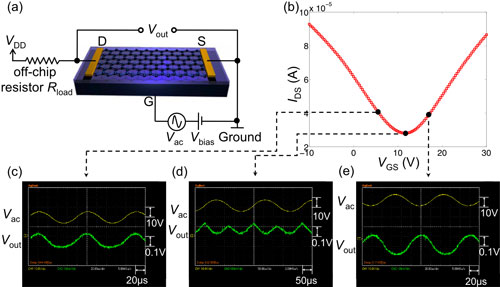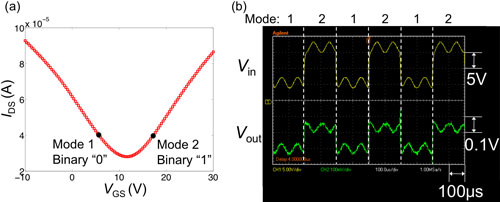| Posted: Oct 11, 2010 | |
Novel graphene amplifier is a major step from single devices to circuits |
|
| (Nanowerk Spotlight) Transistors are the fundamental building blocks of modern electronic devices. Depending on whether they are used to amplify or switch electronic signals they can be grouped into amplifiers and switches. Transistor switches form the basis of all digital circuits in computers where they control on/off operations. Transistor amplifiers are inserted into circuits to amplify current, voltage or power. | |
| While industry is continuing to shrink transistors to ever smaller dimensions – Intel has already demonstrated 22nm SRAM circuits where an area as small as a fingernail holds over 2.9 billion transistors – nanotechnology researcher are busy building transistors from the bottom up (see for instance "Researchers build transistor with just seven atoms"). | |
| Graphene is one of the 'hottest' materials in nanoelectronics labs. This material remains capable of conducting electricity even at the limit of nominally zero carrier concentration because the electrons don't seem to slow down or localize. In the ultimate nanoscale transistor – dubbed a ballistic transistor – the electrons avoid collisions, i.e. there is a virtually unimpeded flow of current. Ballistic conduction would enable incredibly fast switching devices. Graphene has the potential to enable ballistic transistors at room temperature. | |
| But graphene researchers are also working on other practical developments. Recent work for instance could lead to graphene amplifiers that will reduce the complexity of communication circuits used in wireless applications – such as Bluetooth and RFID – and increase their speed. | |
| So far, there have been no research reports on a graphene-based transistor amplifier and investigations of its in-field controllability for analog, mixed-signal, and radio-frequency (RF) applications. Previous work on graphene transistors has largely focused on frequency multiplication near the Dirac point in graphene current-voltage characteristic. | |
| But now, a team of researchers from Rice University and University of California, Riverside (UCR) has demonstrated the first triple-mode graphene amplifier. The team included Kartik Mohanram, assistant professor of electrical and computer engineering at Rice University, Alexander Balandin, professor of electrical engineering and chair of materials science and engineering at UC Riverside and graduate student researchers Xuebei Yang and Guanxiong Liu. The Rice University researchers are experts in circuit design and optimization, while the UC Riverside researchers are experts in graphene and graphene device fabrication. | |
| Using their complementary expertise, the Rice-UCR team has shown experimentally that by leveraging the ambipolarity of charge transport in graphene, the amplifier can be configured in the common-source, common-drain, or frequency multiplication mode of operation by changing the gate bias. | |
| This is the first demonstration of a single-transistor amplifier that can be tuned between different modes of operation using a single three-terminal transistor. Moreover, during its operation, the graphene amplifier was configured in-field to switch between the different modes. The result marks another important step toward graphene applications in electronics. | |
 |
|
| Figure 1: (a) The schematic for triple-mode graphene amplifier. (b) The I-V characteristics of the graphene transistor. (c), (d), (e) are the output of the amplifier at different biasing points. (Image: Dr. Balandin, Dr. Mohanram) | |
| This important advancement in graphene technology will shortly appear in ACS Nano ("Triple-Mode Single-Transistor Graphene Amplifier and Its Applications"; doi:10.1021/nn1021583). A preprint of the paper is available on arXiv. | |
| "This work demonstrates that a graphene circuit can realize the modulation necessary for phase shift keying and frequency shift keying, which are widely used in wireless applications such as Bluetooth, RFID, and ZigBee," Mohanram explains to Nanowerk. "Compared with conventional designs for such applications, which use complex designs based on multiple unipolar transistors, our proposed amplifier has the advantages of a simplified structure with lower parasitics, larger bandwidth, and lower power consumption. As progress is made in graphene-based thin films for transparent and printable electronics, such simple circuits deliver both high functionality and in-field configuration capability necessary for large-scale integration and commercialization." | |
 |
|
| Figure 2: Binary phase shift keying (BPSK) modulation with graphene amplifiers: (a) biasing points and (b) experimental results. (Image: Dr. Balandin, Dr. Mohanram) | |
| According to Balandin, for future work the team plans to use more advanced top-gate transistors, which would allow them to achieve higher gain because of the much smaller gate oxide thickness. "In my laboratory we have already built and experimentally demonstrated the top-gate graphene transistors with low flicker 1/f noise" he says. "Low noise operation of graphene transistors is essential for any analog and communication applications" (see "Graphene transistors can work without much noise"). | |
| Mohanram adds that "ideally, the gain for an amplifier should be greater than one. However, it is a matter of semantics and several exceptions exist. For instance, the common-drain amplifier has a theoretical voltage gain that is always less than one. But we still call it an 'amplifier'. Its current gain is theoretically large." | |
| He notes that reducing the gate oxide thickness and fabricating more robust transistors will help to improve the gain. "There is a lot to be explored in the area of ambipolar circuit design. What we have shown is that even the study of the classical single-transistor amplifier can bring about such a large change in the way we approach circuit design." | |
| The use of graphene in circuit designs may also help to solve the thermal management problem of the advanced high-speed high-integration-density chips. It is known that graphene has an excellent ability to conduct heat. We previously reported the discovery of superior thermal properties of graphene made in Balandin's lab ("'Cool' graphene might be ideal for thermal management in nanoelectronics"). | |
 By
Michael
Berger
– Michael is author of three books by the Royal Society of Chemistry:
Nano-Society: Pushing the Boundaries of Technology,
Nanotechnology: The Future is Tiny, and
Nanoengineering: The Skills and Tools Making Technology Invisible
Copyright ©
Nanowerk LLC
By
Michael
Berger
– Michael is author of three books by the Royal Society of Chemistry:
Nano-Society: Pushing the Boundaries of Technology,
Nanotechnology: The Future is Tiny, and
Nanoengineering: The Skills and Tools Making Technology Invisible
Copyright ©
Nanowerk LLC
|
|
|
Become a Spotlight guest author! Join our large and growing group of guest contributors. Have you just published a scientific paper or have other exciting developments to share with the nanotechnology community? Here is how to publish on nanowerk.com. |
|
